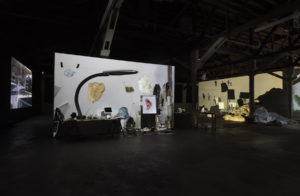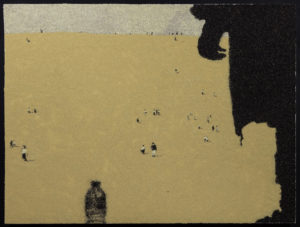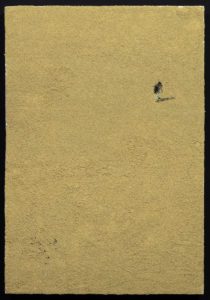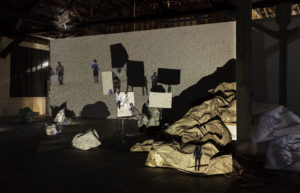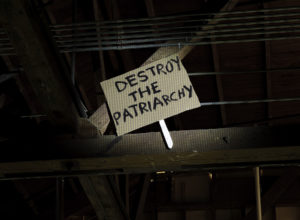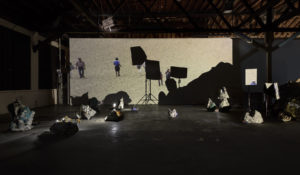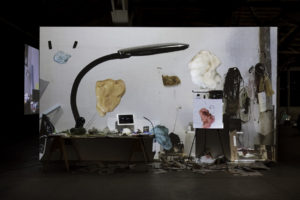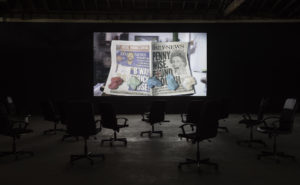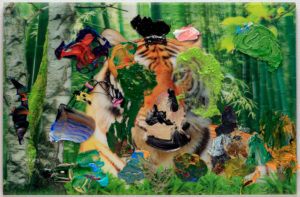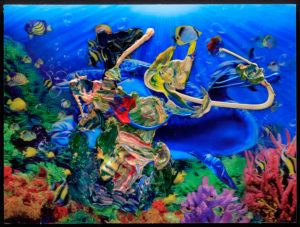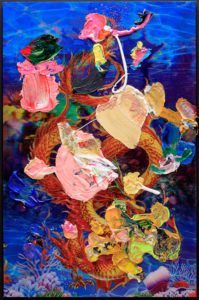Trisha Baga: Biologue
- Trisha Baga in conversation with Sabrina Gschwandtner, January 2017
Sabrina Gschwandtner: The title of the whole show is Biologue. Do you consider the longer 3D video the centerpiece of the show, or one element of the show?
Trisha Baga: It’s the centerpiece. It’s on the main stage.
SG: It’s titled The Voice. After watching it, I thought, if this was being shown on Netflix, it would be categorized as a drama. Do you agree?
TB: I thought of it as a mystery.
SG: A mystery! Not a thriller, though?
TB: Maybe like mysteries and thrillers, it would get lumped in there. I was also thinking of the shape of the whole show as an inversion of the “theater in the round.”
SG: You were just telling me that the starting place for this piece was thinking about the Tower of Babel.
TB: I initially thought about making a road trip movie because I went on a road trip with my mother and her siblings in the Philippines and I wanted to take footage from that and use my experience of not really understanding anything people were saying, because they were using a local dialect more than the national language. So I went into a pretty abstract thought space, carrying my camera and imagining language and that’s what started all the Babel thoughts. Maybe with all of my work, but making this piece made it really clear, when making video, it’s usually about some kind of fragmentation of the cinematic body and all the formal elements that create a sense of empathy towards a protagonist. The drama is the separation and then they live their own lives and congregate every so often.
SG: While I was watching it, I was making a list of different types of communication in the video and noticing how they all seem to fail to provide connection. On my list was: VR glasses movie film, newspapers, language (in the form of written language and multiple spoken languages) …
TB: And The Little Mermaid, don’t forget.
SG: Right! I was trying to figure out where the subject was in the piece. You’ve perfectly captured the way we can live split between the physical present and the digital realm at the same time.
TB: Maybe it’s about the expansion of the body? Or the attempt to through images and media and languages. There’s the narrative of mitosis, which I think is connected to this. It’s a cell body dividing into two daughter cells.
SG: Mitosis is the narrative structure of the piece.
TB: I think its structure is its subject and if that, then I think it makes the video more of an object than a story. I was thinking about, for example, Ariel wants love and to have legs. And because she wants these promised things of an otherworld culture she’s seen fragments of, like the artifacts that she’s been collecting, she makes the trade to separate her body. Evidence. So, it’s like that classic narrative of desire for an imagined whole leading to the fragmentation of the self. The stolen voice is represented by the pieces of chewed up gum. I think of this video as the voice that’s separated from itself and having to express itself in other ways.
SG: But a desire for wholeness in a new form?
TB: Yeah, and the shape of the hunger. The hunger is actually kind of the same because a lot of times it’s just for an other. And the hunger stays the same. I also think there’s a hunger for productivity too, or movement. But the shape of it changes through technology and I think this is what the video is looking at.
SG: The shape of productivity changes or the shape of the desire?
TB: Yeah, the shape of the desire. At least what it looks like. I’m just trying out these sentences, I’m not sure if I believe them.
SG: What’s the desire in this case?
TB: I think I’m talking about, in a way, capitalism. And this mentality that it’s actually possible to fill holes.
SG: What is the role of the body in the work ultimately, or maybe outside of this video in particular? I’m thinking about how people are going to sit here and watch this with 3D glasses but they are also going to walk around the space and see a cleaned up version of your work desk, another 3D video of you at work in this space, seed paintings, sculptures of papier mache newspapers with chewed-up gum, and a video you shot of people walking on a beach in Japan. There are a lot of remnants of you in the space, remnants of your physical body and your labor.
TB: Maybe for me body is an environment, if the video as an object is a protagonist. Within this construct, as a viewer you become part of the environment. I think this video also tries to make the body feel not only that it fragments, but those fragmented parts are just in the air potentially and in our pockets often, and the collision of those things. And to reach a mass where you can no longer focus on it as a collection of singularities, but as a plural mass. Also one of the first organizing things I did with editing was collect my shots of audience. And so there’s an audience wearing VR all in a theater together, an audience wearing 3D glasses in a theater together and an audience not wearing 3D glasses in a theater together…and also an audience standing around in a room at a party all wearing VR. And so maybe that’s like…I can’t find the accurate word that names this relationship to the body environment, but maybe they are going through parallel narratives.
SG: So everyone’s just in it together?
TB: Right, a community.
SG: When I think of community I think of connection, but this show is It’s very dystopian. Is there any out here, or agency?
TB: I think the act of making art is a manifestation of agency. I think for me more so than when I try to instrumentalize art -making for agency. There are other places for that. I was thinking recently about how with all of the shit that’s been happening, a symptom or side effect of it is among my friends and fellow progressive, liberal people, is this sense of self-righteousness and preoccupation with “being right” that bleeds into spaces where they are not so productive. Like creative spaces. And it also creates self-consciousness and a lot of boundaries. And I know that boundaries and being correct is obviously really important in journalism and other places. But I think art should always be protected as a place where you can make a lot of mistakes and feel things out because it speaks from abstraction. I know that my desire to make art is rooted in a desire to express and see and share something larger than I could understand otherwise. These other invented languages shouldn’t be oppressed by the counter oppression too.
- Select Reviews

